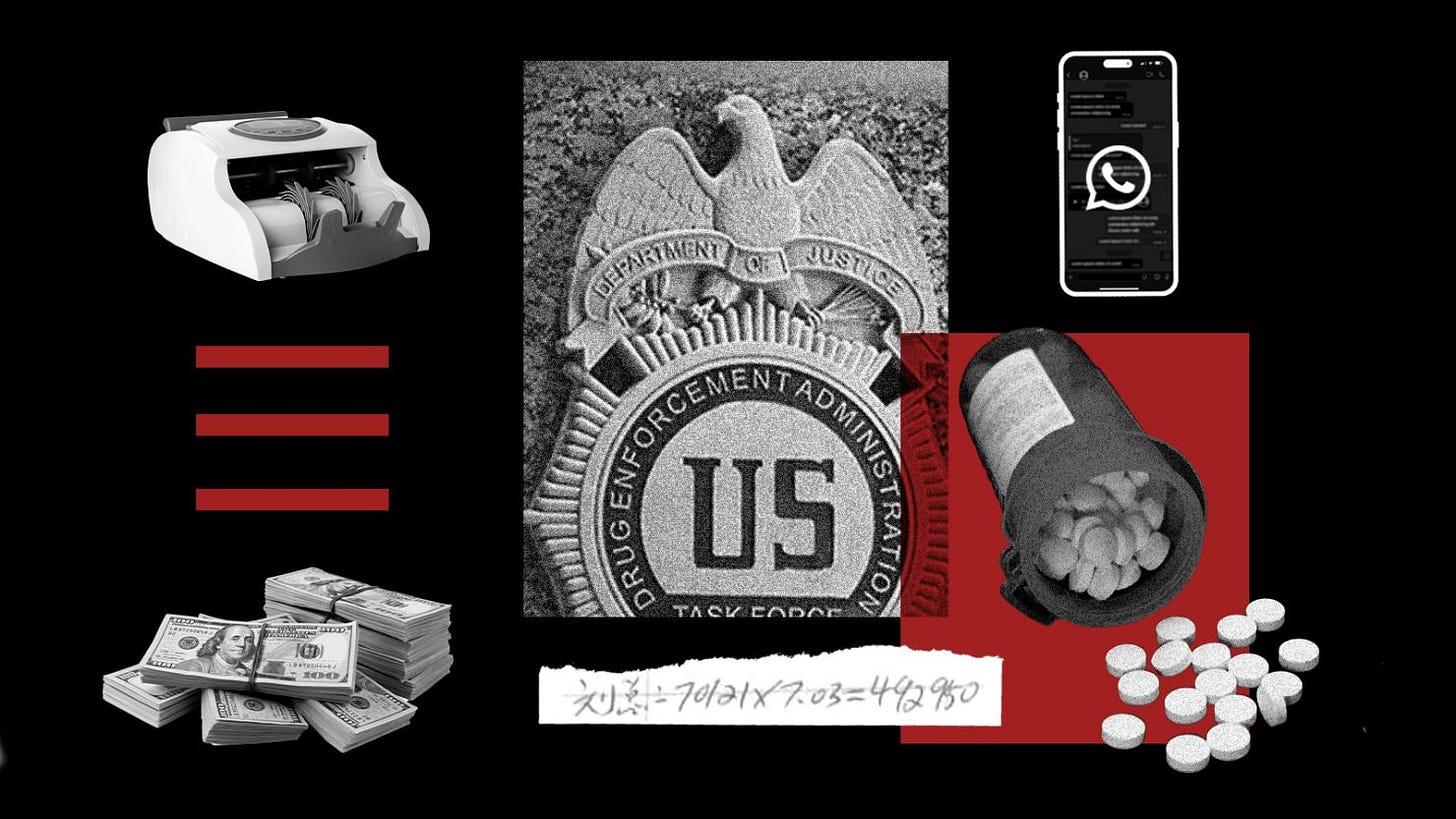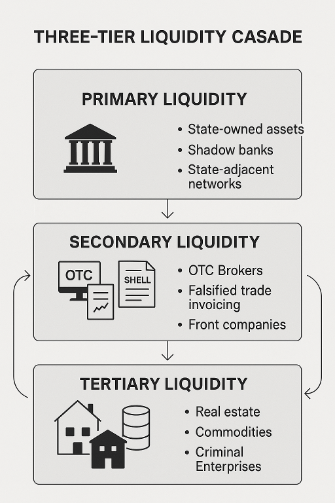FinCEN Names the Game: Chinese Shadow Liquidity in Action
FinCEN’s latest advisory exposes $312 billion in flows, but the real danger is a parallel financial system evolving faster than enforcement.
FinCEN’s new advisory on Chinese Money Laundering Networks (CMLNs) underscores a truth often missed in enforcement reporting: these are not isolated laundering schemes but components of a parallel financial architecture, a shadow liquidity system now entrenched across the Americas and around the world.
The advisory contains staggering numbers: over 137,000 suspicious activity reports (SARs), $312 billion in suspicious flows, and the same trade-based, over-the-counter (OTC), and insider-driven mechanisms. The underlying systems that set off these alerts are the connective tissue that allow sanctioned states, cartels, and elites to thrive despite formal financial controls.
FinCEN frames this as “Chinese money laundering.” And when it comes to cartel finance, Chinese enablers are indeed the most visible. Yet they are only part of a parallel financial architecture — a global ecosystem where Chinese actors are central, but not alone. Other state and non-state players drive and exploit these flows as well. Until regulators and analysts treat shadow liquidity as infrastructure, rather than a collection of anomalous SARs, enforcement will remain reactive while the networks evolve faster than the tools meant to stop them.
Bigger than you think, and more chaotic
These laundering networks are diffuse, but global. They service multi-billion-dollar scam operations in Southeast Asia, terrorist groups like the Houthis, and emerging criminal enclaves in Africa and Latin America. The FinCEN advisory highlights just some of their embeddedness in Western societies, underscoring the scope of this problem.
The sort of networks FinCEN highlights aren’t just laundering for cartels — they’re tapping into a much larger reservoir of Chinese shadow capital. Crypto-enabled, OTC-driven liquidity rails emerged first to move elite wealth offshore, but over the past decade they’ve evolved into a parallel financial architecture. These flows no longer sit neatly under Beijing’s command; they form a sprawling ecosystem of brokers, gray banks, scam centers, and informal clearinghouses that operate beyond the reach of both Western enforcement and the Communist Party itself.
This is what makes the threat so destabilizing: it’s not simply “Chinese laundering,” but a decentralized liquidity system born from state and elite outflows that now finances everything from fentanyl supply chains to dual-use tech procurement. In other words, what started as controlled leakage has become a global shadow infrastructure — chaotic, adaptive, and only partially answerable to any state.
Drug cartels, scammers, and terrorists are just the visible tip of this hidden architecture. They set off SARs and grab headlines, but they are a symptom, not the disease. To understand how we got here, Between the Lines has developed a three-tiered model that tracks the money cascade from its source.
The Three-Tiered Liquidity Approach
Drug cartels, scammers, and terrorists are the visible tip of this hidden architecture. They set off SARs and grab headlines, but they’re only the final chapter in a much longer story. To understand how we got here, Between the Lines has developed a three-tiered model that tracks the money cascade from its source.
Tier 1: The Seed Money. Vast capital outflows from countries like China, Russia, and Iran fund alternative criminal ecosystems outside global jurisdictions. The true danger of these countries lies not in their strength, but in their weakness — an inability to stem elite graft and offshore leakage that fuels shadow economies worldwide. Although these governments rely on offshored liquidity, they cannot control it once it’s outside the country - leaving them ultimately vulnerable.
Tier 2: The Enablers. Operating in a legal gray zone, these brokers and businesses aren’t quite illegal enough to shut down without hard evidence. They thrive in lax regulatory environments, running OTC crypto desks, gray exchanges, and shell firms. They provide the escape valves for Tier 1 elites, and the laundering services that Tier 3 bad actors depend on.
Tier 3: The Headline Grabbers. These are the actors you see in FinCEN advisories and blockchain analytics reports. Southeast Asian scammers, Iranian proxies, Mexican cartels — all exploit this ecosystem. Some build entire operations on Tier 1 outflows; others simply tap it for laundering. They kill, rob, and enslave, but remain only the tip of the iceberg. Authorities shut down one operator, while the deeper pool of shadow liquidity ensures they always resurface somewhere new.
Some Tier 3 operators, like Southeast Asian scammers were built directly on Tier 1 capital outflows enabled by Tier 2 operators.
Others, like Mexican cartels, came to the game later, accessing Tier 2 channels to legitimize their ill-gotten gains.
What they all have in common is that they are the dirtiest players in the game: terrorists, drug traffickers, slavers, and thieves on a massive scale.
Reports highlighting asset seizures are comforting. So are those on the shutdown of gray exchanges like Russia’s Garantex. But in every case, the real operators reconstitute somewhere else with impunity. Until we find a way to go after these cascades systematically, the cycle will continue unabated, threatening global security on practically every level.
Between the Lines’ proprietary Predictive Intelligence Pipeline
What Between the Lines Offers
Before we can disrupt these networks, we need to understand them. Between the Lines exists to map the shadow liquidity systems that underpin global crime, state corruption, and geopolitical instability.
Where others focus on symptoms — the cartels, the scams, the terror groups — we dig into the architecture: the hidden financial scaffolding that sustains them. Our analysis blends geopolitics, macroeconomics, open-source intelligence, and financial investigation with years of institutional memory tracing capital outflows from Beijing, Moscow, and Tehran to scam compounds in Southeast Asia and fentanyl traffickers in Mexico. Beyond mapping the networks, Between the Lines is developing models to anticipate and time these flows with as much precision as possible.
We share the doctrine publicly — models like the three-tiered liquidity approach that explain how capital moves, why enforcement fails, and where interventions could succeed. But we can’t afford to give it all away for free. The real value lies in tailoring this framework to specific risks: a bank’s exposure to shadow liquidity, a government’s vulnerability to illicit flows, or a regulator’s blind spots in enforcement. Those require bespoke reports and private briefings, built to solve problems no generic red flag can.
For policymakers, compliance officers, and investigators, Between the Lines provides more than headlines — it delivers the clarity and strategy needed to actually disrupt these networks. For readers, it offers a rare vantage point on the hidden infrastructure reshaping global security and finance.





